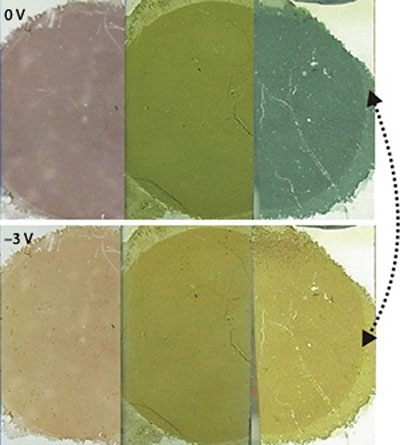| Jul 19, 2011 |
Electrically controlling the optical properties of carbon nanotube at visible wavelengths
|
|
(Nanowerk News) Smart glass can change color or even go from opaque to transparent with just the flick of a switch. Indium tin oxide is used as an electrical contact in many of these 'electrochromic' devices because it is both transparent to visible light and a good conductor of electricity. But indium and tin are both becoming increasingly expensive as the global supply diminishes. Kazuhiro Yanagi from the Tokyo Metropolitan University, working with colleagues from across Japan, has now shown that carbon could be the perfect replacement ("Electrochromic Carbon Electrodes: Controllable Visible Color Changes in Metallic Single-Wall Carbon Nanotubes").
|
 |
| Carbon nanotube films change color when subject to an applied voltage. (© 2011 Wiley-VCH)
|
|
Graphene sheets, consisting of a single atomic layer of carbon atoms in a honeycomb framework, can be rolled into a tube just a nanometer or so in diameter. These carbon nanotubes are highly conductive, mechanically strong, electrochemically stable and can show bright colors depending on how the sheet is rolled. Yanagi and his team have now shown that carbon nanotubes are also electrochromic.
|
|
The optical properties of carbon nanotubes can be altered by changing the density of electrons in the tube. Visible color change is achieved by applying a voltage of at least 2 V across tube when suspended in an electrolyte solution. Previous research has suggested that the nanotubes become photo-electrochemically unstable under these conditions. Yanagi and his colleagues, however, were able to prepare samples with good electrochemical stability using ionic liquids and density-gradient purifications. This combination reduced possible unexpected electrochemical reactions.
|
|
The novel electrochromic device consisted of a thin film of carbon nanotubes on a glass substrate. The team demonstrated the electrochromic function of their device using three different samples with different tube diameters. On application of a –3 V potential, 1.4 nm-diameter nanotubes went from a blue-green in color to yellow, 1.0 nm tubes turned from magenta to yellow-orange, and the initially yellow 0.84 nm sample changed to light yellow (see image). In all cases, the color returned to normal when the voltage was switched off. "Next, we would like to control the optical absorption causing the yellow color so we can get a highly transparent sheet of nanotubes, which could be important for electrochromic display applications," says Yanagi.
|

